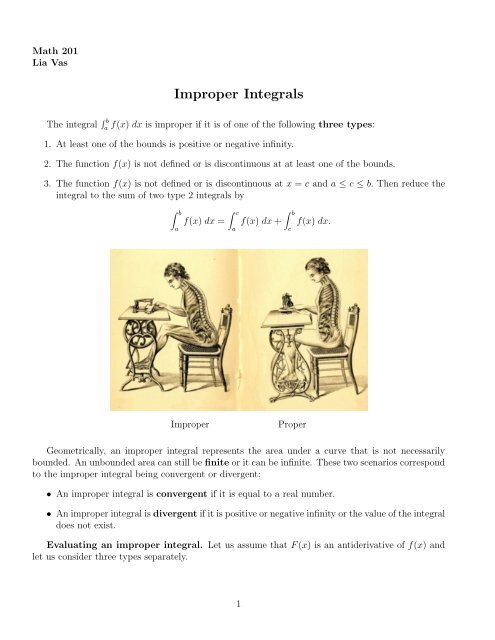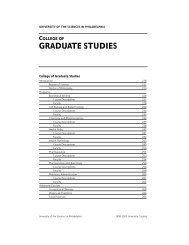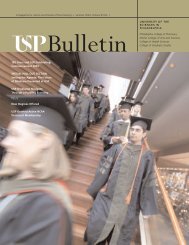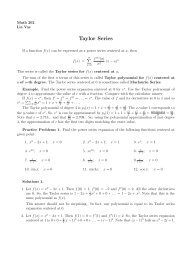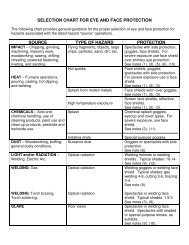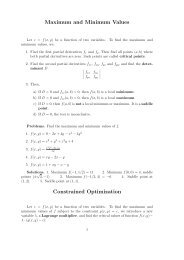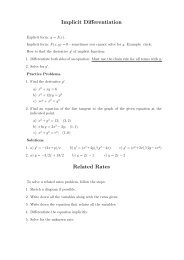Improper Integrals
Improper Integrals
Improper Integrals
- No tags were found...
You also want an ePaper? Increase the reach of your titles
YUMPU automatically turns print PDFs into web optimized ePapers that Google loves.
Math 201Lia Vas<strong>Improper</strong> <strong>Integrals</strong>The integral ∫ ba f(x) dx is improper if it is of one of the following three types:1. At least one of the bounds is positive or negative infinity.2. The function f(x) is not defined or is discontinuous at at least one of the bounds.3. The function f(x) is not defined or is discontinuous at x = c and a ≤ c ≤ b. Then reduce theintegral to the sum of two type 2 integrals by∫ baf(x) dx =∫ caf(x) dx +∫ bcf(x) dx.<strong>Improper</strong>ProperGeometrically, an improper integral represents the area under a curve that is not necessarilybounded. An unbounded area can still be finite or it can be infinite. These two scenarios correspondto the improper integral being convergent or divergent:• An improper integral is convergent if it is equal to a real number.• An improper integral is divergent if it is positive or negative infinity or the value of the integraldoes not exist.Evaluating an improper integral. Let us assume that F (x) is an antiderivative of f(x) andlet us consider three types separately.1
1. ∫ ∞af(x) dx = limt→∞F (x) − F (a).Note that “plugging the upper bound in F (x)” boils down to evaluating the limit of F (x) whenx → ∞. If this limit is a finite number, the integral is convergent. Otherwise, it is divergent.2. ∫ ba f(x) dx if f(x) is not defined at x = b can be evaluated as∫ baf(x) dx = lim F (x) − F (a).t→b −Note that “plugging the upper bound in F (x)” boils down to evaluating the limit of F (x) whenx → b − . If this limit is a finite number, the integral is convergent. Otherwise, it is divergent.∫ ba f(x) dx if f(x) is not defined at x = a can be evaluated as∫ baf(x) dx = F (b) − limt→a + F (x).Note that “plugging the lower bound in F (x)” boils down to evaluating the limit of F (x) whenx → a + . If this limit is a finite number, the integral is convergent. Otherwise, it is divergent.3. Reduce a type-3 integral to a sum of type 1 or 2 integrals.Practice Problems.a) Determine whether each integral is convergent or divergent. Evaluate those that are convergent.1. ∫ ∞2. ∫ ∞3. ∫ 14. ∫ ∞10101x 2 dx1x dx1x 2 dx1x 2 dx5. ∫ 1−113√x2 dx6. ∫ ∞xe −2x dx7. ∫ ∞0−∞xe −2x dx2
8. ∫ ∞b) Find the error in the following reasoning ∫ 1−1 1 x 2 dx = − 1 x |1 −1 = −1 − 1 = −2.1ln xx 2c) Sketch the region and find its area (if the area is finite)1. x ≤ 0, xe x ≤ y ≤ 0.2. x ≥ 3, 0 ≤ y ≤ 1(x−2) 23. x ≥ 0, 0 ≤ y ≤ 1(x−2) 2Solutions. a)1. ∫ ∞ 11 dx = ∫ ∞x 2 1 x −2 dx = x−1−1 |∞ 1 = −1x |∞ −11 = lim x→∞ − ( −1)= 1 + 1 = 0 + 1 = 1. We have ax 1 ∞finite number as an answer. This means that the area under the curve 1 from 1 to ∞ is finitex 2and that the integral is convergent.2. ∫ ∞11x dx = ln x|∞ 1dx= lim x → ∞ ln x − ln 1 = ∞ − 0 = ∞. Thus, the integral is divergent.3. Note that this is a type 2 integral: it is improper because 1 is not defined at the lower boundx 2x = 0. ∫ 10 1 dx = x−1x 2 −1 |1 0 = −1 − lim 1 x→0 −1 + = −1 − (−∞) = ∞. So, the integral is divergent.x4. Note that this is a sum of a type 1 and a type 2 integrals: it is improper both because of the∞ and because of 0 in the bounds. Separate it as a sum of integrals ∫ a0 + ∫ ∞a for any positivea. For example, you can take a = 1 you have that ∫ 10 1 dx + ∫ ∞ 1x 2 1 dx. The first integral isx 2divergent by the previous problem. Thus, regardless of the fact that the second is convergent(it is equal to 1 by the first problem), the sum of the two integrals is not finite.You can think of the sum of the two integrals in this case as the sum of two areas under 1 . Thex 2first, from 0 to 1, is not finite and the second, from 1 to ∞ is equal to 1. The sum ∞ + 1 = ∞.So, the integral ∫ ∞0 dx is not finite – it is divergent.1x 215. This is a type 3 integral: it is improper because 3√ = x 2x−2/3 is not defined at 0 and 0 isbetween the bounds -1 and 1. Separate the integral into the sum of two integrals of type 2∫ 1 1−1 3√ dx = ∫ 0 1x 2 −1 3√ dx+∫ 1 1x 2 0 3√ dx = x 2 3x1/3 | 0 −1+3x 1/3 | 1 0 = 3(0)−3(−1)+3(1)−3(0) = 3+3 = 6.So, the integral is convergent.6. Find the antiderivative first. Note that you can do that using the by-parts method withu = x and dv = e −2x dx. Obtain that the antiderivative −12 xe−2x − 1 4 e−2x = −x − 1 . Thus∫ 2e 2x 4e 2x ∞0 xe −2x dx = −x | ∞ 2e 2x 0 − 1 | ∞ 4e 2x 0 . For the value at the upper bound in the first part, consider−x−1lim x→∞ . Use L’Hopital’s rule to get lim2e 2x x→∞ = −1 = 0. The value at the upper bound4e 2x ∞1in the second part is lim x→∞ = 1 = 0.4e 2x ∞Thus, the integral is −x | ∞ 2e 2x 0 − 1 | ∞ 4e 2x 0 = (0 − 0) − (0 − 1) = 1 . The integral is equal to a finite4 4number and so it is convergent.∫7. Note that this is a sum of two type integrals: ∞−∞ xe−2x dx = ∫ 0−∞ xe−2x dx + ∫ ∞0 xe −2x dx.Note that you can use any other number instead of 0 for the upper bound in the first andthe lower bound in the second part. However, given the previous problem, we can use 0. By3
the previous problem, the second integral is convergent. The first one is ( )−x− 12e 2x 4e |0 2x −∞ =| 0 −∞ = −1 − ∞ . Here you can think of ∞ as ∞· 1 = ∞·∞ = ∞. Thus, the first integral4 0 + 0 + 0 +− ∞ = −∞ and so it is not finite. So, the sum of two integrals is divergent.−(2x+1)4e 2xis −148. Find the antiderivative first. Note that you can do that using the by-parts method with u = ln xand dv = 1 dx. Obtain that the antiderivative − ln x − 1. Thus ∫ ∞ ln xx 2 x x 1 dx = − ln xx 2x |∞ 1 − 1 x |∞ 1 . For− ln xthe value at the upper bound in the first part, consider lim x→∞ . Use L’Hopital’s rule to getx−1/xlim x→∞ = −1 = 0. The value at the upper bound in the second part is lim 1 ∞ x→∞ 1 = 1 = 0.x ∞Thus, the integral is − ln xx |∞ 1 − 1 x |∞ 1 = (0 − 0) − (0 − 1) = 1. The integral is equal to a finitenumber and so it is convergent.b) Note that the integral is improper because 0 is between the bounds -1 and 1. So, it has tobe separated as the sum of two type 2 improper integrals ∫ 1−1 1 dx = ∫ 0x 2 −1 1 dx + ∫ 1x 2 0 1 dx. Bothx 2integrals are divergent (see problem 3 for the second one, the first one can be evaluated similarly).So, the initial integral is divergent as well.c)1. The condition x ≤ 0 indicated the bounds of the integration −∞ < x ≤ 0. The secondcondition indicate the lower and upper y-curves: y = xe x is the lower and y = 0 is the uppercurve. Thus, the area A can be found as ∫ 0−∞ (0 − xex )dx = ∫ 0−∞ −xex dx. Use the integrationby parts to find the antiderivative −xe x + e x . So A = −xe x | 0 −∞ + e x | 0 −∞. For the first part, notethat lim x→−∞ −xe x = −∞ · 0. This requires the use of L’Hopital’s rule. Write your function as−xto obtain ∞ form. Then use the rule to get lim e −x ∞ x→−∞ −1 = 1 = 0.−e −x ∞For the second part, note that lim x→−∞ e x = 0.Thus, A = −xe x | 0 −∞ + e x | 0 −∞ = (0 − 0) + (1 − 0) = 1. So, the area is finite and it is equal to 1.2. The condition x ≥ 3 indicated the bounds of the integration 3 ≤ x < ∞. The second conditionindicate the lower and upper y-curves: y = 0 is the lower and y = 1 is the upper curve.(x−2) 2Thus, the area A can be found as ∫ ∞3 ( 1− 0)dx = ∫ ∞ 1(x−2) 23 dx = (x−2)−1 | ∞ (x−2) 2 −1 3 = −1x−2 |∞ 3 == 0 + 1 = 1. So, the area is finite and it is equal to 1.−1− −1∞ 13. Similarly to the previous problem, the area A can be found as A = ∫ ∞ 10 dx. Note that this(x−2) 2integral is improper both because of the infinity in the bounds and because the value x = 21at which the function is not defined, is between the bounds. So, you need to write this(x−2) 2integral as a sum of improper integrals, each of which will be either type 1 or 2. For example,you can do that as follows.A =∫ 20∫13(x − 2) dx + 2 2∫1∞(x − 2) dx + 2 31(x − 2) 2 dx.The first integral ∫ 2 10 dx is equal to −1(x−2) 2 x−2 |2 0 = lim −1x→2 − − −1 = −1 − 1 = ∞. Even withoutx−2 −2 −∞ 2evaluating the remaining integrals, you can conclude that the area is not finite based just onthis first integral. If you evaluate the second integral, you should get ∞ as well. The third isequal to 1 by the previous problem.4


